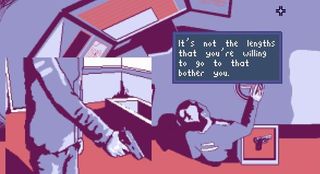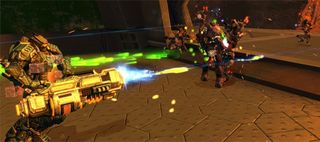Tell us all a little bit about how Tomorrow corporation was formed and where the idea/inspiration for Little Inferno came from?
Gray: The three of us met at grad school at Carnegie Mellon University almost 10 years ago, and collaboratedon a few projectstogether. Back in those days, starting a game company right out of school was virtually unheard of. This was back when indie meant grungy non-showering musicians, steam was scalding hot water vapor, and digital distribution meant sending chain emails full of cat photos.
Instead, we all got jobs at Electronic Arts. After a few years, however, we wanted to make our own mark on the industry. Kyle left to form 2D Boy and create World of Goo with the talented Ron Carmel, while I pitched Hatsworth internally at EA. After both games finished the three of us got back in touch and started Tomorrow Corporation.
We spent a few months talking and meeting over what we should make. Having come off of a platformer, and a physics-puzzler, the only thing we knew for sure was we wanted to make something unique, something experimental, something that was different from everything else out there and couldn’t possibly be compared to our previous games Little Inferno was the perfect fit – something no other company would be dumb enough to make!
When did you start developing games? What got you into programming and designing?
Blomquist: I started programming a few years before the Internet became a thing because back then, computers didn’t really do much else. I started making games right away because games and homework were pretty much the 2 pillars of my life at the time, and I didn’t want to make a program about doing homework (a missed opportunity.)
Gabler: I learned about programming and failure making crappy text adventure games with QBASIC as a kid in the 90’s.
Gray: I always wanted to make games growing up, but I was a horrible programmer. Luckily, my skills were adequate enough to make games in Flash, otherwise I’d probably be doing something else now.
What game do you remember from your childhood that inspired you to make games?
Blomquist: Metroid was one of the earlier games that I became totally obsessed with. When you’re willing to spend hours with your NES Advantage turbo controller finding and cataloging random passwords, you know that a game has affected you somehow. Poor imitations of Metroid are a large part of my game making history.
Gabler: In the 80’s or 90’s there was a game called Beast on our green and black DOS computer. You were an ASCII diamond, and you moved around in a mutable maze with little ASCII H’s chasing you. If they touched you, you died. But you could crush them by smashing them between walls or trapping them in confined areas. I was terrified of those H’s. And then they started laying eggs.
Gray: I grew up with an Atari and an Apple 2, but was never allowed to have an NES – so I’d always end up at my friends’ houses playing their copies of Zelda and Mario. The game worlds always seemed so rich, and full of mystery and wonder. What happens if I push that rock? What if I fall down that pipe? Although those games were much more limiting by today’s standards, they certainly felt limitless as a kid. Once my grandparents bought me an NES for my 8th birthday (I was a spoiled kid), I knew what I wanted to do with the rest of my life.
[private_insider]
When did you start working on Little Inferno? What is your favorite moment or feature? and are you guys complete pyromaniacs?
Gray: When we started Tomorrow Corporation, the first thing we started working on was a game called “Robot and the Cities that Built Him”,a title based off of Kyle’s prototype of the same name. ( http://2dboy.com/RobotAndTheCities/) In that game the player’s goal is to amass a small army of robots to decimate anything in their path. But after some time, we felt it was too traditionally gamey, and we wanted to make something much more experimental.
Gabler: It’s not REALLY about fire. This is an indie game! The fire is a metaphor for something or other!
I have to admit that after playing through the game, I can’t help but feel like this is a spiritual successor to World of Goo. From the art style/characters to the post-modern narrative, Kyle Gabler certainly has made his creative mark. You could almost replace Tomorrow Corporation with World of Goo corporation in the game’s narrative. Why is Little Inferno a Tomorrow Corporation game and not a 2d Boy game?
Gabler: Although I’m a part of both 2DBOY and Tomorrow Corporation, the two indie studios are entirely separate. More about the distinction here! http://tomorrowcorporation.com/posts/who-are-you-tomorrow
While brainstorming a new game, we knew that anything we built would be immediately compared to World of Goo simply because I was involved. So we sought to make a game that could not possibly be compared to our previous games. It would NOT be a physics puzzler, or a platformer, or be about moving something from one point to another point. We thought we’d try to build an entirely new kind of game that no one had ever played before.
What would you say to critics who think Little Inferno is too simplistic, short, easy and/or repetitive? You are on the same screen for nearly the entire game after all.
Gabler: Oh it’s tricky! Because they are right! Of course buying things and throwing them in a fire is simplistic, short, and repetitive. And that’s not an accident. It’s fairly heavy handed, even. The characters in the game have also noticed the same thing – and wonder about it aloud to you in different ways. But why? Why do we continue doing something that’s warm and comfortable, maybe embarrassingly satisfying, even though it’s clearly unproductive? It’s a question the game is fascinated with.
The trouble is, many gamers, and even journalists, are perhaps so used to consuming games at face value that they miss a larger punchline here. It’s a slow, smouldering burn, that pays off for the adventurous players who are willing to be taken on a ride.
How hard was it to develop a game that completely lacks a level structure?
Gray: Having come from a physics puzzler, and a puzzling platformer we wanted to try something completely different. At first we thought this teeny-tiny fireplace game would be a breeze, but it turns out making games without a formal structure is a lot of work. For one, there’s almost nothing reusable!
The amount of content we had to create for Little Inferno was staggering – over 140 unique items, each with custom art, animations, descriptions, and particle systems. In many ways, Little Inferno seems like a smaller game than World of Goo or Hatsworth, but it’s actually much, much bigger!
When developing a game as unique as Little Inferno, what comes first? the gameplay mechanics? or the story? both seem to fit so well together. It’s hard to imagine how your wrapped everything together.
Gray: When we first started, we knew we wanted to make a game based off of the Yule Log TV program – the burning log you find on TV around the winter months in hotel rooms. It originally started in 1967 in New York somewhere as a 17 second loop of burning log. We were immediately drawn to the idea – could we take something with an intentionally incredibly underwhelming premise and then actually make a game that was actually surprisingly good?
Gabler: So, given such an extremely constrained location, we thought about how we could tell a much larger story from such a limited perspective? I kindof feel like that all the time anyway. All kinds of enormous things are constantly happening all over the planet, but the only way I know about them is through a little peep-hole into the world in the form of an internet connection, or newspapers that someone left on the table at a cafe before I got there. And they aren’t always reliable.
If you had more time/money, what if anything would you change about Little Inferno?
Dandy Wheeler, PR Rep: Market research indicates that Steam users would like 15% more pixels in explosions and 300% more bullets!
Are there any plans to expand Little Inferno with more catalogs, DLC, etc? I can’t imagine a sequel, but what else does Tomorrow Corporation have in store for us? Ports to more platforms? The controls would certainly work on touch devices.
Gray: We’re working on porting the game over to Mac and Linux platforms, and translating Little Inferno into a few more languages. Beyond that, it’s whatever makes sense for the game. If it’s fun to play Little Inferno on your Casio wrist-watch, we’ll figure out a way to make that work!
What is your favorite indie game right now? What are you playing or looking forward to from the indie scene?
Blomquist: I finally took the plunge and started playing Terraria recently. My treasure chests grow ever fuller.
Gabler: I’ve recently had a lot of fun with the student-built game Dig n’ Rig. There need to be more games about digging holes.
Gray: Octogeddon, a game where you control a giant octopus with mutant arms – super simple, and simply insane. I’m also really looking forward to Monaco after playing it at IGF years ago – come out already!
What one piece of advice would you give to aspiring developers?
Gabler: The best piece of advice we need to heed ourselves is: Just dive in and make something. Programming language doesn’t matter, destination platform doesn’t matter, just make anything using anything. If it sucks, you’ll know quickly. If it’s promising, you’ll probably re-create the whole thing from scratch anyway.
Dandy Wheeler, PR Rep: Market research has generated some indie game ideas just for you! 1. A platformer where you walk along a straight line, forever, and the rotation of the earth and movement through the solar system generate invisible geometric patterns which are a metaphor for the invisible beauty all around us. 2. An 8-bit shooter where your gun fires ninjas instead of bullets. 3. Rag doll Maya Angelou falling down an infinite hill while a text-to-speech converter reads auto-generated poetry. LOL Love you Tweet me!!
[/private_insider]























